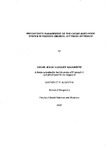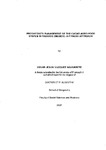PRODUCTIVITY MANAGEMENT OF THE CACAO AGRO-FOOD SYSTEM IN TABASCO (MEXICO): A FITNESS APPROACH
| dc.contributor.author | NAVARRETE, CESAR JESUS VAZQUEZ | |
| dc.contributor.other | Faculty of Science and Engineering | en_US |
| dc.date.accessioned | 2013-09-18T12:20:47Z | |
| dc.date.available | 2013-09-18T12:20:47Z | |
| dc.date.issued | 2007 | |
| dc.identifier | NOT AVAILABLE | en_US |
| dc.identifier.uri | http://hdl.handle.net/10026.1/1856 | |
| dc.description.abstract |
The farming industry and the agro-food system as a whole are now required to adapt to a challenging and more competitive environment. How the food industry can fit itself into such environment is the main question that is addressed in this study. The fitness approach, an exploratory framework, is applied in order to study the Cacao Agro-food System (CAPS) in Tabasco. Mexico. The final sample consisted of 356 farmers, 37 curing plants, 6 wholesaling firms, and 7 chocolate firms. An anatomical model using correspondence analysis was adopted to understand the main features of every industry in the CAPS. The Pitness Appraisal Instrument (FAI) was constructed and applied to determine the relationships between factors and aspects of organisational configuration with 5 key performance indicators of the CAPS farming industry. The anatomy of CAPS revealed that it is based on raw and bulk products, has a potential to diversify vertically and horizontally, and has a dual structure private and union related -which is not appropriate to deal with issues such as free market pressures or lethal fungal diseases. Results of the PAI analysis revealed that both the factors and the aspects of organisational configuration are significantly related to performance indicators. Indeed, 14 of the 20 productivity management elements are significantly related to performance indicators. Moreover, the results show that a set of fittest solutions, rather than a unique solution, exists among farmers. Visualisation of the productivity management elements reveals that participation of organic cacao, education levels, and price setting exert the strongest influence on productivity indicators. The key implication of this study is that both efficiency and effectiveness are the two valid strategies that enable the farming industry to cope with the challenging and competitive environment. The Policy makers should be aware of a set of solutions (fitness landscape) instead of just focusing on individual (often narrow) solution. | en_US |
| dc.language.iso | en | en_US |
| dc.publisher | University of Plymouth | en_US |
| dc.title | PRODUCTIVITY MANAGEMENT OF THE CACAO AGRO-FOOD SYSTEM IN TABASCO (MEXICO): A FITNESS APPROACH | en_US |
| dc.type | Thesis | |
| plymouth.version | Full version | en_US |
| dc.identifier.doi | http://dx.doi.org/10.24382/3731 |
Files in this item
This item appears in the following Collection(s)
-
01 Research Theses Main Collection
Research Theses Main



